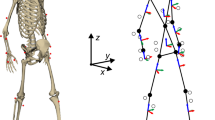Abstract
A full set of governing dynamical equations for Hanavan's human body model are developed. The model consists of ellipsoids, elliptical cylinders, and frustrums of elliptical cones. It contains 34 degrees of freedom. The model is considered to be in an arbitrary force field and the limb motions may be either specified or left free. The governing equations then determine the internal limb moments (muscle forces), the limb displacements, and the displacement of the model itself in an inertial reference frame. An example motion representing the model response to an impulsive force loading is also presented.
Similar content being viewed by others
References
Bartz, J. A. A three-dimensional computer simulation of a motor vehicle crash victim. Cornell Aeronautical Laboratory Report DOT HS-800, 1971. P. 574.
Bayazitoglu, Y. O. Methods for automated analysis of three-dimensional mechanical dynamic systems with application to nonlinear vehicle dynamics. Ph.D. Dissertation, University of Michigan, 1972.
Beckett, R. E., and Pan, K. C. Analysis of gait using a minimum energy approach. Symposium on Biodynamic Models and their Applications. AMRL, WPAFB, 1971. Pp. 823–842.
Chace, M. A., and Bayazitoglu, Y. O. Development and application of a generalized d'Alembert force for multifreedom mechanical systems.Journal of Engineering for Industry 1971,93, 317–327.
Ewing, C. L., and Thomas, D. J. Human head and neck response to impact acceleration. Army-Navy Joint Report, Naval Aerospace Medical Research Laboratory, U.S. Army Aeromedical Research Laboratory, 1972.
Eringen, A. C. McGraw-Hill,Nonlinear theory of continuous media. New York: 1962. P. 447.
Fleischer, G. E. Multi-rigid-body attitude dynamics simulator. JPL Technical Report No. 32-1516, 1971.
Gallenstein, J., and Huston, R. L. Analysis of swimming motions.Human Factors 1973,15, 91–98.
Hanavan, E. P. A mathematical model of the human body. Aerospace Medical Research Laboratory Report AMRL-TR-64-102, 1964.
Hewes, D. E., and Glover, K. E. Development of Skylab Experiment T020 employing a foot-controlled maneuvering unit. NASA-TN D-6674, 1972.
Hooker, W. W. A set ofr dynamical attitude equations for an arbitrary n-body satellite havingr rotational degrees of freedom.AIAA Journal 1970,8, 1205–1207.
Huston, R. L., and Passerello, C. E. On the dynamics of a human body model.Journal of Biomechanics 1971,4, 369–378.
Huston, R. L., and Passerello, C. E. An analysis of general chain systems. NASA-CR 127924, N72-30532, 1972.
Huston, R. L., and Passerello, C. E. On Lagranges form of d'Alembert's principle.Matrix and Tensor Quarterly 1973,23, 109–112.
Jacobs, N. A., Skorecki, J., and Charnley, J. Analysis of the vertical component of force in normal and pathological gait.Journal of Biomechanics 1972,5, 11–34.
Jeffries, H.Cartesian tensors. London: Cambridge University Press, 1957. Pp. 1–16.
Kane, T. R. Dynamics of nonholonomic systems.Journal of Applied Mechanics 1961,28, 574–578.
Kane, T. R.Dynamics. New York: Holt, Rinehart and Winston, 1968. Pp. 177–183.
Kane, T. R. and Wang, C. F. On the derivation of equations of motion.Journal of the Society for Industrial and Applied Mathematics 1965,13, 487–492.
Kane, T. R., and Scher, M. P. Human self-rotation by means of limb movements.Journal of Biomechanics 1970,3, 39.
Kinzel, G. L., Hall, A. S., Jr., and Hillberry, B. M. Measurement of the total motion between two body segments. I. Analytical development.Journal of Biomechanics 1972,5, 93–106.
Kurzhals, P. R., and Reynolds, R. B. Development of a dynamics analytical model of man onboard a manned spacecraft. NASA-TN D-6584, Appendix B, 1972.
Liu, Y. K. The biomechanics of special and head impact: Problems of mathematical simulation. Symposium on Biodynamic Models and Their Applications. AMRL, WPAFB, 1971.
Passerello, C. E., and Huston, R. L. Human attitude control.Journal of Biomechanics 1971,4, 95.
Paul, J. P. Forces transmitted by joints in the human body.Proceedings of the Institute of Mechanics Engineers 1966,181, 8–15.
Robbins, D. H., Bennett, R. O., Henke, A. W., and Alem, N. N. Prediction of mathematical models compared with impact sled test results using anthropometric dummies. Proceedings of the Fourteenth Stapp Car Crash Conference, Paper No. 700907, 1970.
Robbins, D. H., R. G. Snyder, J. H. McElhaney, and V. L. Roberts. A comparison between human kinematics and predictions of mathematical crash victim simulators. Proceedings of the Fifteenth Stapp Car Crash Conference, Paper No. 710849. 1971.
Roberts, V. L., and Robbins, D. H. Multidimensional mathematical modelling of occupant dynamics under crash conditions. Society of Automotive Engineers Paper No. 690248, 1969.
Smith, P. G., and Kane, T. R. The reorientation of a human body in free fall. Stanford University Technical Report 17, 1967.
Smith, P. G., and Kane, T. R. On the dynamics of the human body in free fall.Journal of Applied Mechanics 1968,35, 167.
Steward, P. A., Duffy, J., Soechting, J., Litchman, H., and Paslay, P. R. Control of the human forearm during abrupt acceleration. Symposium on Biodynamic Models and Their Applications. AMRL, SPAFB, 1971. Pp. 193–210.
Young, R. D. A three dimensional mathematical model of an automobile passenger. Texas Transportation Institute Research Report. 1970. Pp. 140–142.
Author information
Authors and Affiliations
Rights and permissions
About this article
Cite this article
Huston, R.L., Passerello, C.E., Hessel, R.E. et al. On human body dynamics. Ann Biomed Eng 4, 25–43 (1976). https://doi.org/10.1007/BF02363556
Received:
Issue Date:
DOI: https://doi.org/10.1007/BF02363556




